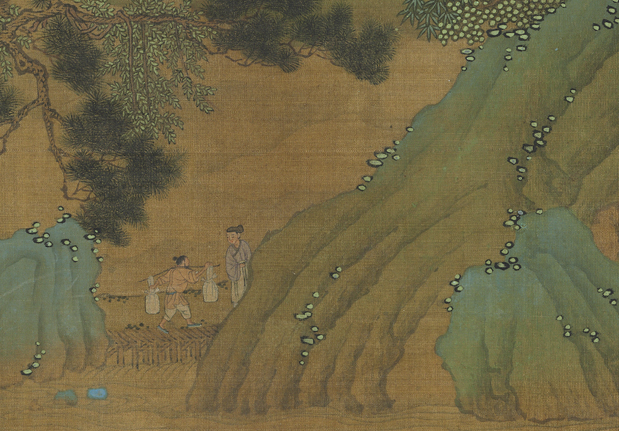“Qing Yin Ge Kai Yan Generals and Scholars” in the “Pingding Taiwan War Album”
“Qing Yin Ge Kai Yan Generals and Scholars” in the “Pingding Taiwan War Album”, Emperor Qianlong of the Qing Dynasty, anonymous painting, paper version, colored, 55.6 cm long, 91.1 cm wide
On the upper part of the painting, Emperor Qianlong inscribed a poem with the following words: “Give the triumphant General Fu Kang’an, Counselor Hailancha, and other feasts, and present them at the banquet. Emperor Qianlong’s Wu Shen and Meng Qiu’s imperial pen.” Seal the seal with the seal of “Guxi Emperor”, the seal with the seal of Zhu Wenfang, “Youri Zizi”, the seal with the seal of Bai Wenfang, and the seal with the seal of “Supreme Emperor”, the seal with the seal of Zhu Wenfang. The “Sanxi Tang Jingjian Seal”, Zhu Wenyin, and “Yizi”, Bai Wenyin, were printed and sealed by the internal government of the Qing Dynasty. “Qianlong Appreciation” is stamped with a seal in white. Wushen “was the 53rd year of the Qianlong reign (1788), when Emperor Qianlong was 78 years old
Picture the scene of Emperor Qianlong’s celebration at Qingyin Pavilion in Chengde Mountain Resort, Hebei Province, where he entertained generals such as Fukang’an and Hailancha who had done meritorious service, and the monarch and officials watched the auspicious play together. The Qingyin Pavilion and the Changyin Pavilion Grand Theater in the Forbidden City are constructed in the same form, with three layers of happiness, wealth, and longevity. These three layers can simultaneously present characters, ghosts, and immortals, giving people a more comprehensive and strong visual experience. This painting has a strong sense of reality, and the artist meticulously portrays characters and buildings with neat and delicate strokes. Although there are many characters, each of which is only a few inches in size, the accurate proportion of the modeling, the clothing and clothing in accordance with the standard system, and the characteristics of portraits of important figures such as the Emperor Qianlong, have important historical value
In the 51st year of Qianlong’s reign (1786), Lin Shuangwen, the leader of the Fujian Heavenly and Terrestrial Society residing in Taiwan, led an uprising against the corrupt bureaucracy of the Qing government stationed in Taiwan. In the face of the raging uprising, Emperor Qianlong sent troops to Taiwan to suppress it many times since the 52nd year of Qianlong’s reign (1787), and at the same time ordered the imperial envoy Fu Kang’an to supervise military affairs. Under the command of the brave and resourceful Fu Kang’an, the Qing army, relying on the close cooperation of the “Yimin Xiang Yong” in Taiwan, which was hostile to the Tiandi Hui Party, finally reversed the situation of being passively attacked everywhere, and successively arrested the leaders of the rebel army, Lin Shuangwen, Zhuang Datian, and others. After suppressing the uprising, Emperor Qianlong took some targeted measures. For example, in the 53rd year of Qianlong’s reign (1788), Emperor Qianlong approved the 16 articles of the Constitution of the “Investigation of Taiwan’s accumulated malpractices, Consideration of Remedies,” which were reviewed by the Grand Master and the Nine Priests, and published by Fu Kang’an, in order to strictly clarify Taiwan’s official governance and strengthen management. From then on, the Qing government’s rule over Taiwan entered a new stage
In order to commemorate the victory of the pacification of Taiwan, Emperor Qianlong ordered court painters to create a set of documentary “The pacification of Taiwan War Album” in accordance with the convention of drawing a war atlas for each major battle. This atlas begins on October 28th, the 52nd year of Qianlong’s reign, when General Fu Kang’an marched into Taiwan and ends with Emperor Qianlong entertaining the victorious soldiers and soldiers who returned from the summer resort in the 53rd year of Qianlong’s reign. It vividly records the process of suppressing the Lin Shuangwen Uprising from more than ten battles, including the siege of Jiayi, the Battle of Tai Po Lin, the Battle of Dou Liu Men, the Battle of Da Li Yan, and the Battle of Ji Ji Pu
![图片[1]-Illustrated Books of the Battle of Pingding Taiwan: Qingyin Pavilion Kaiyan Soldiers-China Archive](https://chinaarchive.net/Warring States period/painting/51830[1024].jpg)
![[Qing Dynasty] British female painter—Elizabeth Keith, using woodblock prints to record China from the late Qing Dynasty to the early Republic of China—1915-China Archive](https://chinaarchive.net/wp-content/uploads/2022/11/image-191x300.png)




